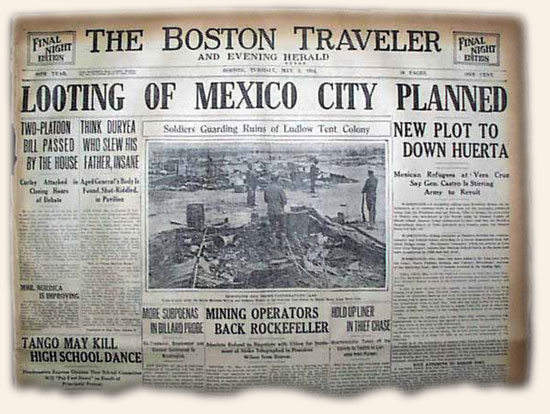It’s amazing what one often finds buried in old newspapers…
June 22, 2017 by GuyHeilenman · Leave a Comment
 Flowers, leaves, photos, clumps of hair, historic trinkets… The list of what might be found buried within and among the inside pages of historic newspapers continues to foster our love for the collectible. The latest discovery? As we were scanning a September 22, 1880 issue of The Boston Investigator hoping to find a mention of Thomas Edison (which turned out to be successful), we noticed an article titled: “Strange Tribe Of Jews Discovered In The Caucasus”, which turned out to be quite interesting:
Flowers, leaves, photos, clumps of hair, historic trinkets… The list of what might be found buried within and among the inside pages of historic newspapers continues to foster our love for the collectible. The latest discovery? As we were scanning a September 22, 1880 issue of The Boston Investigator hoping to find a mention of Thomas Edison (which turned out to be successful), we noticed an article titled: “Strange Tribe Of Jews Discovered In The Caucasus”, which turned out to be quite interesting: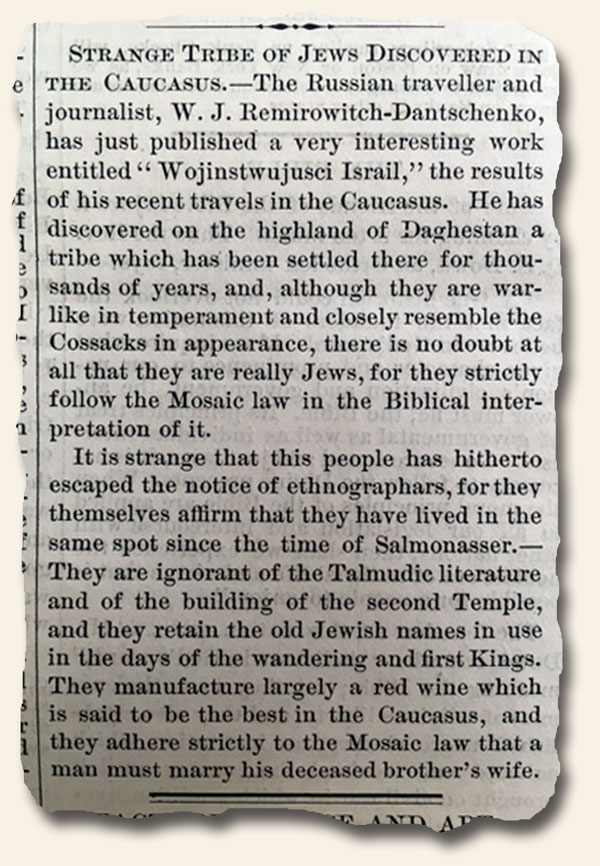
Does anyone know… re: Sabbatai…
April 20, 2017 by GuyHeilenman · 2 Comments
Whereas we have many original newspapers containing Judaica-themed content, finding issues with mentions of Sabbatai are quite rare. If you’ve never heard of Sabbatai Zevi, the infamous 17th century, self-proclaimed, long awaited Jewish Messiah who converted to Islam, he’s certainly worth exploring. We recently came across a report in an Oxford Gazette (issue #8) from 1665 which we believe may very well be his first mention in a bonafide newspaper (see below). The problem with “firsts” is that a first is only a first as long as a newly unearthed earlier first doesn’t relegate the older first to a second. 🙂
Has anyone ever viewed or heard of an earlier mention of him in a newspaper?
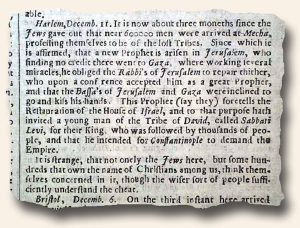
The impact of graphics – Golda Meir’s death…
April 13, 2017 by GuyHeilenman · Leave a Comment
Over the past several years we’ve been running a series: Great Headlines Speak For Themselves. However, as true as this may be, quite often corresponding illustrations, photos, and other graphics speak volumes. In my humble opinion, such is the case with the front page of the *St. Petersburg Times dated December 9, 1978 (see below). I’m not a graphic designer by an means, but I couldn’t help but be impacted by the emotion portrayed by Jack Barrett’s illustration. If I were in charge of handing out awards…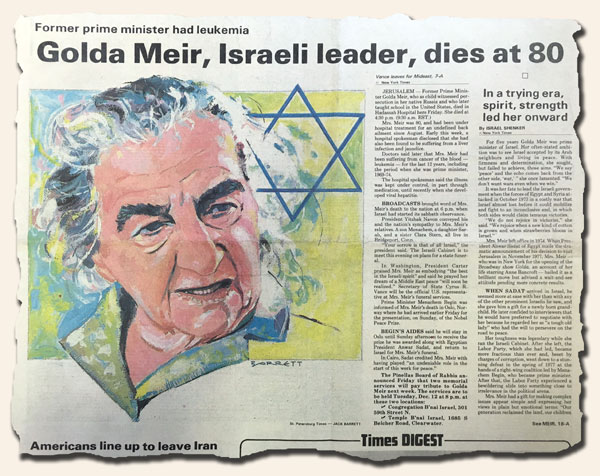 *Considering her place of birth (Russia), I also appreciate the irony that this great item appears in the St. Petersburg Times (albeit St. Petersburg, Florida).
*Considering her place of birth (Russia), I also appreciate the irony that this great item appears in the St. Petersburg Times (albeit St. Petersburg, Florida).
The Traveler… Rabbi Gershom Seixas… 1st native-born American rabbi…
July 4, 2016 by The Traveler · Leave a Comment
Today I traveled back to New York City by the means of the New York Evening Post dated July 2, 1816. Under the “Died” column is “Departed this life, at 9 o’clock this morning, the Rev. Mr. GERSHOM SEIXAS, the venerable Pastor of the Hebrew congregation, in the 71st year of his age…”.
 Mr. Seixas was the first Native-born American rabbi. He also delivered the first Thanksgiving address in an American synagogue after the adoption of the United States Constitution. He was one of the fourteen ministers to participate in George Washington’s first inauguration.
Mr. Seixas was the first Native-born American rabbi. He also delivered the first Thanksgiving address in an American synagogue after the adoption of the United States Constitution. He was one of the fourteen ministers to participate in George Washington’s first inauguration.
At the merger of the 200th anniversary of his death and the 240th anniversary of the American Declaration of Independence it is fitting to consider how quickly the Jewish population became acclimated and accepted in the United States. While not without considerable bumps in the road, George Washington’s outspoken support for Jewish citizens was certainly a good beginning.
Question: Washington’s letter to the Hebrew Congregation in Newport, RI received a response from Rabbi Moses Seixas. If anyone can confirm whether or not Moses and Gershom were related, please contact Guy at guy@rarenewspapers.com.
~The Traveler
The Traveler… getting benched…
June 6, 2016 by The Traveler · Leave a Comment
 Today I traveled to New York City by the way of The New York Times dated June 6, 1916. I found that history took place in Washington, D.C. “Every available seat in the courtroom of the United States Supreme Court was occupied at noon today when Louis D. Brandeis of Boston took his seat on the bench as an Associate Justice of that august tribunal… Chief Justice White, rising announced the appointment of Mr. Brandeis,… then announce the readiness of Mr. Brandeis to take the judicial oath, which was administered,… Justice Brandeis was then escorted by Frank Key Green, the Marshal of the court, to his seat on the extreme left of the bench. Members of the court bowed as he passed…. Mr. Brandeis took his seat…”.
Today I traveled to New York City by the way of The New York Times dated June 6, 1916. I found that history took place in Washington, D.C. “Every available seat in the courtroom of the United States Supreme Court was occupied at noon today when Louis D. Brandeis of Boston took his seat on the bench as an Associate Justice of that august tribunal… Chief Justice White, rising announced the appointment of Mr. Brandeis,… then announce the readiness of Mr. Brandeis to take the judicial oath, which was administered,… Justice Brandeis was then escorted by Frank Key Green, the Marshal of the court, to his seat on the extreme left of the bench. Members of the court bowed as he passed…. Mr. Brandeis took his seat…”.
Mr. Brandeis was the first Jewish Supreme Court Justice, which was bitterly contested as he “…was a militant crusader for social justice whoever his opponent might be. He was dangerous not only because of his brilliance, his arithmetic, his courage. He was dangerous because he was incorruptible . . . [and] the fears of the Establishment were greater because Brandeis was the first Jew to be named to the Court.” He was eventually confirmed by the Senate by a vote of 47 to 22 in 1916, to become one of the most famous and influential figures ever to serve on the high court. His opinions were, according to legal scholars, some of the “greatest defenses” of freedom of speech and the right to privacy ever written by a member of the Supreme Court…” per wikipedia.
~The Traveler
Peace on earth, good will toward men… The Year of Jubilee…
January 21, 2016 by GuyHeilenman · Leave a Comment
While I am certainly not an expert on Jewish sacred days, festivals, and special/holy celebrations, one significant event has always captured my imagination: The Year of Jubilee – referred to by some as The Golden Jubilee. It was such a celebration which led President Warren Harding to write a letter to the Union of American Hebrew Congregations in response to their invitation for him to attend the Golden Jubilee Dinner in 1923. This letter was printed in The New York Times, January 25, 1923. While we often quote the phrase “Peace on earth, good will toward men”, few are aware of its roots (Luke 2:14) or its significance and/or relationship to the Year of Jubilee. While President Harding (a non-Jew) was certainly not a popular president, this is one instance where his “good will toward men” was well-received. His letter is as follows:
The Traveler… A commuted sentence… the angry mob and more…
June 22, 2015 by The Traveler · Leave a Comment
Today I traveled to New York City by the way of The New York Times of June 22, 1915. There I found the headlines announcing Governor Slaton of Georgia had commuted the sentence of  convicted killer Leo Frank to life in prison. “The death sentence imposed on Leo M. Frank for the murder of Mary Phagan has been commuted to one of life imprisonment by Governor John M. Slaton, and Frank is now in the State Prison at Milledgeville…” This news was not received well by the community and soon a crowd of up to 10,000 marches were upon the governor’s home. An effigy of the governor was burned. In the meantime, Leo Frank was secretly moved from the Atlanta prison to one in Milledgeville. This issue carries extensive coverage on this matter.
convicted killer Leo Frank to life in prison. “The death sentence imposed on Leo M. Frank for the murder of Mary Phagan has been commuted to one of life imprisonment by Governor John M. Slaton, and Frank is now in the State Prison at Milledgeville…” This news was not received well by the community and soon a crowd of up to 10,000 marches were upon the governor’s home. An effigy of the governor was burned. In the meantime, Leo Frank was secretly moved from the Atlanta prison to one in Milledgeville. This issue carries extensive coverage on this matter.
~The Traveler
The Traveler… Mexican irony… dirty dancing prohibited!
May 5, 2014 by The Traveler · Leave a Comment
Today I traveled back to Boston by the means of The Boston Traveler and Evening Herald dated May 5, 1914. There I found a banner headline (see below) “Looting of Mexico City Planned”, with subheadlines, “New Plot to Down Huerta” and “Mexican Refugees at Vera Cruz Say Gen. Castro Is Stirring Army to Revolt.” How ironic to have this headline on the day of Cinco de Mayo — typically a special day of celebration in Mexico!
Also… The Boston school systems were being faced with a new dilemma… the dance craze, the tango! Due to this dance and other such “modern dances”, the headmasters were not going to take any chances with having these dances performed and were putting their foot down and cancelling all of the dances. And 3/4 of a century later, “Dirty Dancing” makes millions upon millions!
Additionally… The Leo Frank murder trial continues, with testimony that includes the accusation that he paid someone to lie for him.
The Traveler… Leo Frank… “Watchful, Waiting”…
April 7, 2014 by The Traveler · Leave a Comment
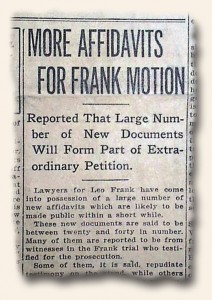 Today I traveled through Atlanta, Georgia by the way of The Atlanta Constitution dated April 7, 1914. There I found the defense attorneys for Leo Frank had come into possession of a large number of new affidavits which would be made public shortly. Also coverage of the war in Mexico between Carranza and Pancho Villa. This also has the reporting of the Fall of Torreon with the reporting of the expulsions of the Spaniards.
Today I traveled through Atlanta, Georgia by the way of The Atlanta Constitution dated April 7, 1914. There I found the defense attorneys for Leo Frank had come into possession of a large number of new affidavits which would be made public shortly. Also coverage of the war in Mexico between Carranza and Pancho Villa. This also has the reporting of the Fall of Torreon with the reporting of the expulsions of the Spaniards.
“Watchful, Waiting” policy is how Lloyd Brown was dealing with his 14-year marriage as he was bringing a divorce suit to court. He said shortly into the marriage his wife “began to take a violent dislike to him… She had not only left the house, but had taken all the covers off the bed before so doing. I borrowed some more from a neighbor and, when my wife came back in the morning,…I explained to her that to her that things couldn’t go along that way much longer… I just sat there and said nothing. Well, that made her madder and madder, I just sat still and kept quiet. Finally she hit me over the head with a fire shovel.” She left that night and never returned. Divorce granted.
~The Traveler
Headlines drive interest in World War II…
March 11, 2013 by TimHughes · 2 Comments
For likely a multitude of reasons, interest in World War II newspapers ranks far higher than in the Korean War, World War I, or the Spanish-American War. It may be a generational thing, as most collectors today are children of World War II veterans and likely heard stories of the war first-hand, or found 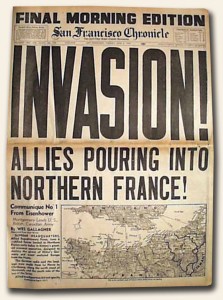 newspapers in their parents attics which sparked an interest. One could debate a number of other possible reasons why other wars lack the intrigue found in that fought by the “greatest generation”.
newspapers in their parents attics which sparked an interest. One could debate a number of other possible reasons why other wars lack the intrigue found in that fought by the “greatest generation”.
Headline collecting has always been a focus for this hobby, and as any collector knows, bold, banner headlines did not become commonplace until late in the 19th century. With the increasing competitiveness of daily newspapers across the country–Hearst, Pulitzer & others rising to prominence–flashier front pages were needed to draw attention at the corner news stand. It’s a shame there is not more interest in the Spanish-American War and World War I as both events resulted in some huge, dramatic, & very displayable headlines.
Because there are a plethora of newspapers from the WWII era available, collectors have become very discriminating in what they collect. Only the “best of the best” will do, meaning just the major events and only those with huge and displayable headlines. If there is a “top 6” list of sought-after events, our experience is they would be: 1) attack on Pearl Harbor; 2) the D-Day invasion; 3) death of Hitler; 4) end of the war in Europe; 5) dropping of the atomic bomb; 6) end of the war in the Pacific. One could add any number of other battle reports such as Midway, battle of the Bulge, fall of Italy, Iwo Jima, battle for Berlin, and so much more. And we could step back before American involvement in the war and add Hitler’s invasion of Poland and the battle of Britain.
The bigger the headline the better. With some newspapers the entire front page was taken up with a headline and a related graphic. The U.S. flag was a common patriotic device. Tabloid-size newspapers commonly had the front page entirely taken up with a singular headline and tend to be better for display given their smaller size.
 And not just American newspapers draw interest. German newspapers hold a special intrigue, but the language barrier is a problem for many. But the British Channel Islands, located in the English Channel between England & France, were occupied by the Nazi during the war so their reports were very pro-Nazi while printed in the English language (ex., Guernsey Island). And the military newspaper “Stars and Stripes“, while certainly being American, was published at various locations in Europe and the Pacific. Collectors have a special interest in finding World War II events in the official newspapers of the American military forces. Plus there were a multitude of “camp” newspapers, amateur-looking newspapers printed on a mimeograph machine for consumption limited to a military base, and typically printed is very small quantities. Their rarity is not truly appreciated by many.
And not just American newspapers draw interest. German newspapers hold a special intrigue, but the language barrier is a problem for many. But the British Channel Islands, located in the English Channel between England & France, were occupied by the Nazi during the war so their reports were very pro-Nazi while printed in the English language (ex., Guernsey Island). And the military newspaper “Stars and Stripes“, while certainly being American, was published at various locations in Europe and the Pacific. Collectors have a special interest in finding World War II events in the official newspapers of the American military forces. Plus there were a multitude of “camp” newspapers, amateur-looking newspapers printed on a mimeograph machine for consumption limited to a military base, and typically printed is very small quantities. Their rarity is not truly appreciated by many.
For obvious reasons, there is also a high degree of collectible interest from those wishing to make sure certain aspects of history are not forgotten. The Holocaust, and the Nazi propaganda used to provide a rationale for eliminating the Jewish people, is well documented in newspapers from the era. In addition to the Holocaust and its atrocities, issues providing context through reporting other pre-war events such as the Great Depression, fascism, and increased militarism, are also desirable.
True to any collectable field, newspaper collectors are always on the lookout for an issue better than what they have, and collection upgrades are constant. Finding that special, rare, unusual or fascinating headline is what makes the hobby fun. Will interest in the Korean War and the Vietnam War gain more interest in future years? Perhaps so. With interest currently low and availability and prices very attractive, it might be a good time to explore.



